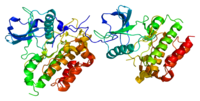
Photo from wikipedia
Named for its assembly near exon-exon junctions during pre-mRNA splicing, the exon junction complex (EJC) regulates multiple aspects of RNA biochemistry, including export of spliced mRNAs from the nucleus and… Click to show full abstract
Named for its assembly near exon-exon junctions during pre-mRNA splicing, the exon junction complex (EJC) regulates multiple aspects of RNA biochemistry, including export of spliced mRNAs from the nucleus and translation. Transcriptome analyses have revealed broad EJC occupancy of spliced metazoan transcripts, yet inhibition of core subunits has been linked to surprisingly specific phenotypes and a growing number of studies support gene-specific regulatory roles. Here we report results from a classroom-based RNAi screen revealing the EJC is necessary for regeneration in the planarian flatworm Schmidtea mediterranea. RNAi animals rapidly lost the stem and progenitor cells that drive formation of new tissue during both regeneration and cell turnover, but exhibited normal amputation-induced changes in gene expression in differentiated tissues. Together with previous reports that partial loss of EJC function causes stem cell defects in Drosophila and mice, our observations implicate the EJC as a conserved, posttranscriptional regulator of gene expression in stem cell lineages. This work also highlights the combined educational and scientific impacts of discovery-based research in the undergraduate biology curriculum.
Journal Title: Developmental biology
Year Published: 2019
Link to full text (if available)
Share on Social Media: Sign Up to like & get
recommendations!